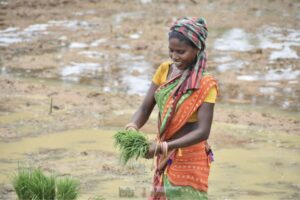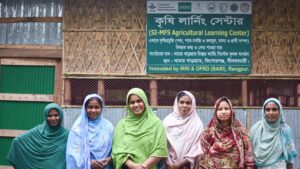by Wanju Shi, Xinzhen Zhang, Juan Yang et al.
High temperatures cause significant yield losses in major rice-growing areas of the world, posing a stiff challenge in meeting the demand for rice from a steadily increasing population. Given that global warming is expected to continue with more frequent heat episodes, adaptation of field-scale crop management practices for preventing heat-induced yield and grain quality losses is vital. Water management is considered to be one of the important practices to prevent yield losses under high air temperature conditions.
The global mean air temperature has increased by 0.6–0.8 °C during the last century and is predicted to rise by 1.6, 2.4, and 4.4 °C between 2021–2040, 2041–2060, and 2081–2100, respectively. High temperatures cause significant yield losses in major rice-growing areas of the world, posing a stiff challenge in meeting the demand for rice from a steadily increasing population.
In China, frequent and extreme high temperatures during flowering and grain-filling stages resulted in significant yield loss from 8.9% in the 1970s to 17.9% in the early 21st century, particularly in the Yangtze River Valley. Further, it is predicted that total rice production in China would decrease by 5.3%–11.4% under 1.5 °C and 2.0 °C warming scenarios.
Given that global warming is expected to continue with more frequent heat episodes, adaptation of field-scale crop management practices for preventing heat-induced yield and grain quality losses is highly necessary.
More than 57% of the world’s rice is grown under irrigated conditions with a standing water depth of 0–10 cm during the entire crop growth period. Thus, growth and developmental processes for irrigated rice are strongly influenced by water management. Water management impacts the microclimate including soil and canopy temperature, nutrient uptake, phenology, and morphology of a rice plant, ultimately affecting rice grain yield and quality.
Water management is also considered to be one of the important practices to prevent yield losses under high air temperature conditions. For example, deep-flood irrigation or continuous irrigation with running water, decreased soil and water temperature, increased the available assimilate supply per grain, and improved grain quality by reducing the proportion of chalky (milky-white) grains.
Increasing the depth of irrigation could delay leaf senescence, enhance cellular osmoregulation, and grain filling, therefore minimizing yield reduction caused by heat stress. However, pragmatically, water management practices are not always easy to implement as only a few farmers can afford abundant and controlled irrigation. This is further complicated as high temperatures are almost always accompanied with low precipitation in most rice-growing areas resulting in water scarcity.
Therefore, alternate water management practices that utilize less water are proposed. It has been shown that alternate wetting and moderate soil drying instead of continuous flooding maintained higher grain yield and better grain quality under heat stress. In addition, irrigation with cooler water has been considered to counteract the adverse effects of high-temperature stress.
In Japan, irrigation with cool water (17 °C) reduced the occurrence of milky-white grains in japonica cultivar by extending the root activity and delaying leaf senescence under high air temperature. Recently, it was found that irrigating with underground water (cooler water) in the morning, followed by draining the water in the afternoon could adjust the canopy and soil temperature in field-grown indica hybrid rice.
But this study did not look at the impact of irrigation on grain yield and quality.
Canopy temperature often reflects the complex interactions between the energy absorption and dissipation mechanisms within the canopy, thus directly impacting yield-determining processes and final rice productivity.
Under heat stress, canopy temperature is strongly associated with yield fluctuations as it is a major indicator of transpiration cooling or stomatal activity, linking tissue temperature and heat avoidance. In an effort to manage canopy temperature under high-temperature conditions, recent field studies have shown that water mist spray helps to lower the temperature within rice canopy, reduce the peroxidation of membrane lipids, increase leaf photosynthesis, and thereby significantly improve heat avoidance.
Hence, in the present study, we hypothesize that irrigating with cooler belowground water would reduce both soil and canopy temperature and thereby minimize heat stress-induced damages in rice.
Studies on implementing appropriate water management practices during periods of high temperature is limited compared with those quantifying the impact of high temperatures on rice responses. In addition, both water management and canopy temperature play important roles in determining the productivity of heat-stress prone flooded rice.
Groundwater level in the Yangtze River basin is abundant and remains stable even in the dry season. This unutilized water has a high potential to be exploited as irrigation water. Therefore, field experiments were conducted, wherein high temperature and water treatments were imposed starting from heading to maturity in two hybrid rice cultivars.
The major objectives of the study were to (i) evaluate the effects of irrigation with cooler belowground water on the thermal environment, including air temperature at the canopy level and soil temperature; and (ii) quantify the response of rice grain yield and quality under independent and combined high temperature and irrigation treatments.
The effect of cooler irrigation water in counteracting heat stress-induced damage is cultivar-dependent and was ineffective in reducing yield and quality losses under heat stress conditions. Irrigation with cooler water altered soil temperature but not air temperature at the canopy level in rice paddy fields further warranting the need to study other management and genetic options to reduce canopy temperature in rice under high-temperature stress.
A deeper understanding of cultivar differences in tissue temperatures and their responses to high-temperature stress and irrigation water temperature treatments is an important area for future research.
Read the study:
S Wanju, Zhang X, Yang J, et al. 2023. Irrigating with cooler water does not reverse high-temperature impact on grain yield and quality in hybrid rice. The Crop Journal, Volume 11, Issue 3: 904-913






